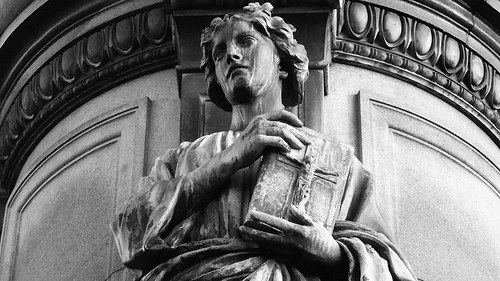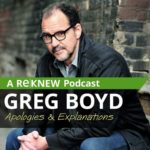We run our website the way we wished the whole internet worked: we provide high quality original content with no ads. We are funded solely by your direct support. Please consider supporting this project.

History and Bible: Do They Align?
To begin, it is significant that when Jesus and the authors of the NT referred to their sacred writings as “God-breathed,” they were referring to the writings that had been handed down to them. So too, the text that the Church has always confessed to be “God-breathed” has been the canon she received. Never has the “God-breathed” nature of the text been affixed to oral or written versions of the biblical material that preceded the written text. For this and other reasons, I find that the “God-breathed” status and divine authority of Scripture attaches to its final canonical form. This alone is the text we are called to wrestle with, with the ultimate goal of discerning how any given passage bears witness to the faithful and merciful covenantal God who was definitively revealed in Christ.
This means, among other things, that our estimation of a passage’s “God-breathed” nature and/or its divine authority should not hinge upon anything like historical-critical considerations. While source and redaction criticism may at times shed light on the pre-history of a text that may be relevant to its exegesis, neither these nor any other branch of biblical criticism should ever be allowed to affect our estimation of the final form of a passage. The fact that a portion of Scripture may have had a different meaning before it assumed the form it has within the canon is largely irrelevant to the contemporary theological task of hearing God speak through the final form of Scripture.
Moreover, to affirm that the canonical form of a text is “God breathed” is to affirm that its authority as well as its interpretation for the Church is not contingent upon how it does or does not conform to so-called “objective history” (historisch) – viz. to any particular scholarly reconstruction of “what actually happened.”
I am persuaded that we are called to embrace the faith conviction that each passage is trustworthy for the divine purposes for which it was “breathed.” If one happens to be led by the available evidence to the conviction that a particular passage does not correspond to “what actually happened,” then, in my view, this simply indicates that corresponding to “objective history” must not have been part of the theological purpose that God intended for that passage.
We are failing to read biblical narratives as they were originally intended to be read when we read them through the grid of how they do or do not cohere with “objective history.” For in this case we are importing into our reading of the narrative modern concerns that are alien to the text, rather than allowing the text to communicate its concerns to us. To read Scripture faithfully, we must read it with the assumption that the meaning of the canonical passage is found in the text, not outside of it in the way it relates to (someone’s reconstructed version of) “objective history.”
To be sure, I grant that attempting to demonstrate a correlation between biblical accounts and “objective history” may sometimes be highly significant for apologetic purposes. Most importantly, I am convinced that the intellectual plausibility of the Christian faith hangs, to a significant degree, on our ability to demonstrate the general historical reliability of the Gospel portraits of Jesus, which I, along with Paul Eddy, argue for in The Jesus Legend. But as it concerns the call for Jesus-followers to hear and obey God’s voice through Scripture, it’s my conviction that all that matters is the narrative in its final canonical form.
I should add that, while I believe it is important for apologetic purposes to anchor the Gospel portraits of Jesus in verifiable history, I have become convinced that it is apologetically unwise, to say the least, to leverage the credibility of the Christian faith as a whole on the historical veracity of the biblical narrative as a whole. There is no reason the credibility of the faith should be leveraged on a conservative evaluation of historical evidence for every aspect of the biblical narrative, and, in any event, the conservative perspective is, in some instances, very hard to defend in light of the archeological evidence. The more important point for our present purposes, however, is that there is absolutely no reason to tether the traditional faith-affirmation that all canonical texts are “God-breathed” to a particular way of relating any or all of these texts to a scholarly reconstruction of actual history.
Image by byronv2 via Flickr.
Category: General
Tags: Bible, Bible Interpretation, Biblical Criticism, Historical Criticism
Topics: Biblical Interpretation
Related Reading

Drum Roll Please: Greg’s Final Critique of Bart Ehrman’s Article
This is the ninth and final of several videos Greg put together to refute Bart Ehrman’s claims published in the article What Do We Really Know About Jesus? Thanks for hanging in there for this last one. I know it was a long wait, but the holidays got inordinately busy for Greg. In this segment, Greg talks…

Why Bart Ehrman Doesn’t Have to Ruin Your Christmas (Or Your Faith) Part 2
This is the second of several videos Greg put together to refute Bart Ehrman’s claims published in the article What Do We Really Know About Jesus? If you missed it, you can catch the first installment here.

The Cross and the Witness of Violent Portraits of God
In my previous post I noted that the prevalent contemporary evangelical assumption that the only legitimate meaning of a passage of Scripture is the one the author intended is a rather recent, and very secular, innovation in Church history. It was birthed in the post-Enlightenment era (17th -18th centuries) when secular minded scholars began to…

What Bible Translation Do You Recommend?
Greg talks about Bible translations. http://traffic.libsyn.com/askgregboyd/Episode_0051.mp3

New Testament Support for the Warfare Worldview
Warfare in Jesus’ Ministry The theme of God striving to establish his sovereign will (his Kingdom) on earth over and against forces that oppose him is prevalent in the New Testament. In keeping with the apocalyptic climate of the time, there are many references to angels at war with God, demons that torment people, and…

The Cruciform Way of the Lamb
In this video, Greg offers insight into how to read the Bible with the cross at the center of the revelation of God, thereby reframing how we interpret the violent and nationalistic passages of the Old Testament. Travis Reed from The Work of the People did a series of interviews with Greg a while ago and…
